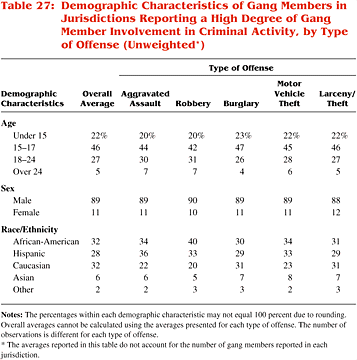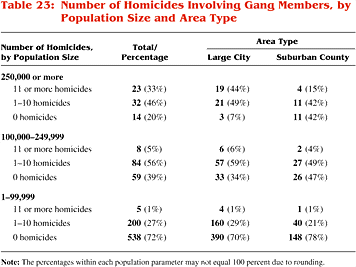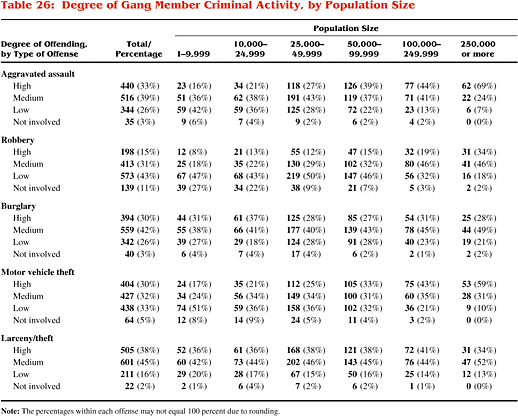Gangs typically have been associated with criminal acts since the first reports of their activities were made (Sante, 1991). Observers of gangs generally agree that, while not all gang members participate in criminal acts, involvement in such activity distinguishes gangs from other groups (Curry and Decker, 1998). The present survey asked respondents to report the number of homicides in 1996 involving gang members and to estimate the degree of gang member involvement in other offenses (i.e., aggravated assault, robbery, burglary, motor vehicle theft, and larceny/theft).
Homicide
Results of the current survey indicated that a substantial number of homicides in 1996 were attributed to gang members. Figure 17 shows that gang members were reportedly responsible for an estimated 2,364 homicides in large cities and 561 homicides in suburban counties in 1996. As noted in the "Methodology" section, there were too few responses from small cities and rural counties to extrapolate the number of homicides for these types of localities.
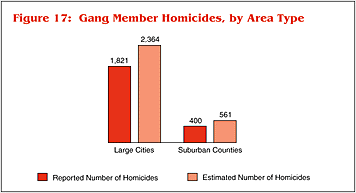
The number of homicides that occurred in large cities and suburban counties in 1996 was associated with population size. Table 23 indicates that the number of homicides varied directly with population size, especially in the Nation's largest cities. Approximately 44 percent of agencies serving cities with populations of 250,000 or more reported more than 10 gang-related or gang-motivated homicides. In contrast, only 6 percent of large cities with populations between 100,000 and 249,999 and only 1 percent of large cities with populations less than 100,000 had more than 10 gang-related homicides. The same effect was present, but less pronounced, in suburban counties. The relationship between population size and the number of homicides in large cities and suburban counties was statistically significant.
| Jurisdictions throughout the country have differing definitions of what constitutes a gang crime. |
Past research has shown that jurisdictions throughout the country have differing definitions of what constitutes a gang crime (Spergel, 1995; Maxson and Klein, 1990). Maxson and Klein (1990) showed that "estimates of the prevalence of gang violence can vary widely among cities using different definitions." Generally, gang crime is classified as either gang related or gang motivated, depending on the jurisdiction. For a crime to be considered gang related, it "must be committed by someone who is a known gang member, is identified as a gang member by a third party, or is suspected of being a gang member" (Decker and Van Winkle, 1996). Additionally, some jurisdictions consider an incident gang related if the victim is a gang member (Maxson and Klein, 1990). A crime is considered gang motivated if the underlying reason is to further the interests and activities of the gang. Only acts that show "a clear link to the gang" are defined as gang motivated (Decker and Van Winkle, 1996).
Survey respondents who indicated that homicides involving gang members had occurred in their jurisdictions in 1996 were asked if these homicides were solely gang motivated. No definition of "gang motivated" was given in the survey. Approximately 73 percent of suburban counties and 69 percent of respondents in large cities indicated that the homicides reported for their jurisdictions were gang motivated.
In this Summary, the questions regarding homicide have been analyzed on a limited basis only. Further analysis will be conducted with data collected by future surveys. In addition, subsequent surveys will focus more attention on the issues surrounding gang crime definitions.
Degree of criminal activity
| A crime is considered gang motivated if the underlying reason is to further the interests and activities of the gang. |
Survey recipients were asked to indicate the degree to which gang members were involved in the following offenses in their jurisdictions: aggravated assault, robbery, burglary, motor vehicle theft, and larceny/theft. These crimes were selected because they are commonly associated with gang activity. As table 24 reveals, agencies most often reported a "high" degree of gang member involvement for larceny/theft (38 percent), followed by aggravated assault (33 percent), burglary (30 percent), and motor vehicle theft (30 percent). Gang members were not extensively involved in robbery, with 11 percent of respondents reporting no involvement and 43 percent reporting a "low" degree of involvement.
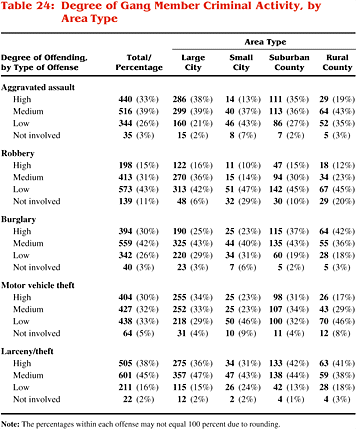
Table 24 also shows the degree of criminal involvement by area type. Compared with small cities and rural counties, both large cities and suburban counties had high degrees of gang member involvement in aggravated assault, motor vehicle theft, and robbery. Suburban and rural counties had higher degrees of gang involvement in burglary than large and small cities. Gang member involvement in larceny/theft was high in all localities but highest in suburban and rural counties.
| Gang member involvement in aggravated assault, robbery, and motor vehicle theft generally increased as the population size increased. |
Criminal activity varied considerably by region (see table 25). Agencies in the West reported the highest degree of gang member involvement in aggravated assault, motor vehicle theft, and robbery. However, robbery involvement was quite low in all regions. Burglary was highest in the South (37 percent) and lowest in the Northeast (9 percent). Larceny/theft was high in all regions, ranging from 21 percent in the Northeast to 42 percent in the South.
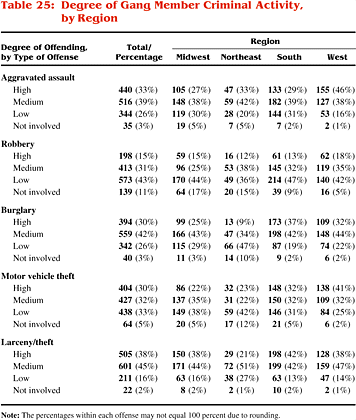
The degree of criminal activity also varied by population size for some crimes. Table 26 shows that gang member involvement in aggravated assault, robbery, and motor vehicle theft generally increased as the population size increased. The degree of involvement in burglary and larceny/theft was not significantly associated with population size. Gang involvement in burglary was estimated to be highest in populations of 10,000 to 24,999 and lowest in populations of 50,000 to 99,999. Gang member involvement in larceny/theft was estimated to be highest in populations of 100,000 to 249,999 and lowest in populations of 250,000 or more.
| The degree of gang member involvement in criminal activity did not vary substantially by sex. |
Table 27 illustrates the demographic characteristics of gang members in jurisdictions that reported a high degree of gang member involvement in criminal activity. When unweighted averages were used, the average proportion of gang members over the age of 18 was higher in jurisdictions that reported a high degree of gang member involvement in robbery and aggravated assault than in jurisdictions reporting the same degree of gang member involvement in burglary, motor vehicle theft, and larceny/theft. The highest average proportion of gang members under the age of 18 was in jurisdictions reporting a high degree of gang member involvement in burglary. The degree of gang member involvement in criminal activity did not vary substantially by sex. The average proportion of male gang members ranged from 88 to 90 percent in jurisdictions reporting a high degree of involvement in all offenses. The highest average proportion of African-American and Hispanic gang members was in jurisdictions reporting a high degree of involvement in robbery, aggravated assault, and motor vehicle theft.
